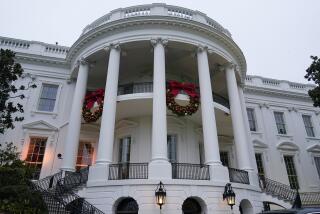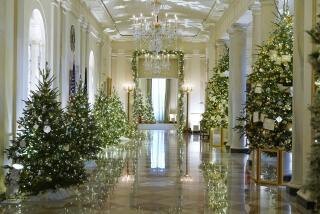Exhibit Reprises White House Christmases
- Share via
CENTERVILLE, Del. — Who will light White House Christmas trees of the future is as much a question mark as the winner of this year’s election has been, but voters can now see the yule traditions of presidents past.
The Winterthur Museum has opened its first White House Christmas tour, a series of displays called “Yuletide at Winterthur: America’s First Families” highlighting the Christmas lore of past White House residents.
The displays range from a re-creation of a snowball fight inside the White House during President Andrew Jackson’s term to a glamorous Christmas tree decorated by Jacqueline Kennedy.
“This is a nice reminder of the grace and beauty of what the White House can be about,” said Elizabeth Murray, a Pennsylvania woman who was taking in the museum’s gilded walls and shining tea services. Some 30,000 people are expected to visit the museum before the tour ends Jan. 7.
Behind one velvet rope stands the mannequin of a boy, his hand brushing the needles of a 2-foot-tall tree decorated with electric lights and hand-drawn Christmas decorations.
It is a rendition of 8-year-old Archie Roosevelt, who in 1902 sneaked the tiny tree into his bedroom after his father, conservation-minded President Teddy Roosevelt, said the White House would not be having a Christmas tree.
The scenes are put together with historical care. The lights on Archie’s tree, for example, are replicas of the round-bulb electrical lights used at the time of his father’s presidency. The Winterthur researchers learned of the tree, and what was on it, from a letter the president wrote to a friend.
In the museum’s glass-walled conservatory is a towering tree decorated with brass horns, angels and painted nutcrackers--a replica of the Kennedys’ 1961 White House tree. Elaine Hall, a Winterthur researcher, used photographs supplied by White House archivists to duplicate the Kennedy tree.
“We try to make everything as authentic as possible,” Hall said.
The tour took Hall and two other Winterthur archivists a year to put together. They pored over letters, diaries, old magazines, even old cookbooks, in search of details to cement the reality of the scenes they were designing.
For example, Winterthur learned the details of a Jan. 4, 1824, party given in the White House of President James Monroe by Vice President John Quincy Adams through the diary entries of Adams’ son, Charles.
The party was to honor Gen. Andrew Jackson, the “Hero of New Orleans,” and the diary told of flower petals and eagles sketched in chalk on the ballroom’s wooden floor and of greens twisted around columns in the rooms.
Detail was vital for the displays, Hall said. When museum workers decided to build a model of a 1,235-pound cheese given to President Thomas Jefferson in 1802, they called a food historian who could tell them what the cheese looked like and what color it would be.
Hence, there is a giant wheel of faux cheese--4 feet, 4 inches across and 15 inches thick--with wedges cut out as if for a presidential wine-and-cheese party.
But the most attention is paid to the presidential Christmas trees.
On a tree decorated in World War II, when metal was scarce, chains of colored paper twist around the boughs instead of shining stars and spheres. The tree has no lights, because Washington under President Franklin D. Roosevelt had blackout precautions to reduce the threat from enemy bombers.
There is a tribute to the first electrified White House tree, for Christmas 1896, in the administration of President Grover Cleveland.
All the china plates and punch bowls in the displays, even eight silver tankards sitting on a side table--all fashioned by Revolutionary War hero Paul Revere, are part of the collection started by Henry Francis du Pont in 1927.
Du Pont’s passion for fine things and restoration was famous. When Jacqueline Kennedy decided to restore the White House, she asked Du Pont to head up the effort. Her handwritten thank-you notes are on display in the museum, next to the conservatory where the replica of the Kennedy Christmas tree stands.
Winterthur still acquires art and other fine things, but its current collection of more than 89,000 pieces was built during Du Pont’s lifetime.
Du Pont also left behind 1,200 boxes of documents: correspondence, receipts and records, all of which are still being sifted through by museum workers.
“They literally saved everything,” Hall said.
More to Read
Sign up for Essential California
The most important California stories and recommendations in your inbox every morning.
You may occasionally receive promotional content from the Los Angeles Times.













